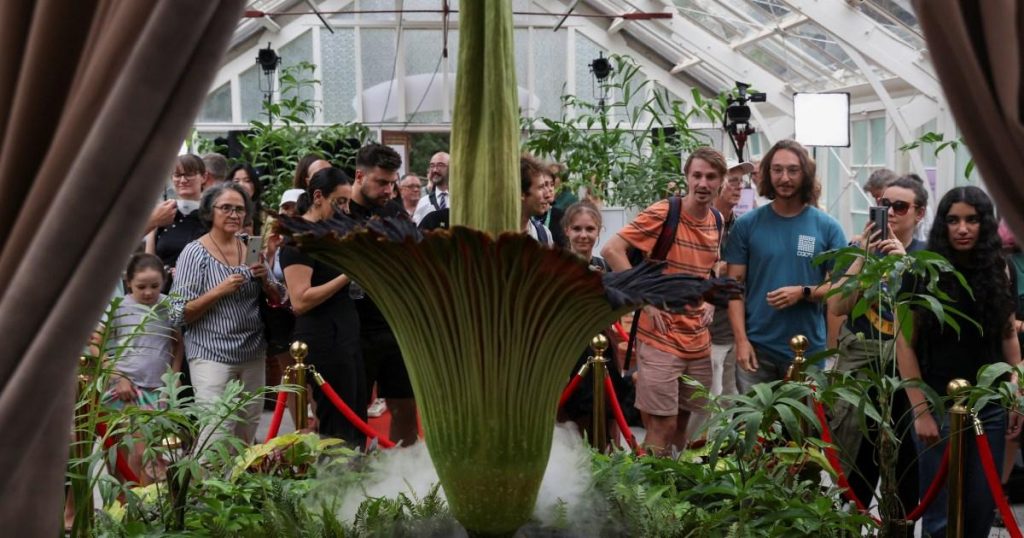The Enthralling Bloom of Putricia, the Corpse Flower
The Royal Botanic Garden Sydney recently witnessed a spectacle of nature as Putricia, a titan arum, or "corpse flower," bloomed for the first time in years. This extraordinary event drew immense public attention, both in person and online, captivating thousands with its rarity and infamy. The titan arum, one of the world’s rarest and smelliest plants, typically blooms only for 24 hours every few years, emitting a pungent odor often described as a mix of decaying flesh, hot cat food, and wet socks. Putricia, nurtured by the garden for seven years after being acquired from the Los Angeles Botanic Garden, became a focal point of fascination, drawing crowds reminiscent of the 2000 Sydney Olympics even before the bloom began.
The anticipation surrounding Putricia’s bloom intensified as a livestream captured its every move. Thousands tuned in, creating a virtual community united by their shared fascination with the plant. The livestream chat became a hub of activity, with viewers creating memes, inside jokes, and acronyms like "WWTF" (We Watch the Flower), "WDNRP" (We Do Not Rush Putricia), and "BBTB" (Blessed Be the Bloom). The anticipation built as days turned into a slow, almost burlesque-like performance, with Putricia finally revealing its dramatic bloom on Thursday. The event was orchestrated with theatrical flair, with visitors walking a red carpet to view the blooming flower from behind velvet ropes, in a scene inspired by Queen Victoria’s funeral, the Rocky Horror Picture Show, and the cinematic style of David Lynch.
The blooming of Putricia elicited a wide range of reactions, from awe and reverence to disgust and amusement. The potent stench emanating from the plant, described as "slaughterhouse-like," did not deter visitors from taking selfies and even leaning in for a closer sniff. The unique experience evoked strong emotions, with one science reporter expressing both sickness and awe, while another visitor displayed a gesture of worship towards the plant. Botanic staff even joined in the celebratory atmosphere, performing viral dances in front of Putricia, adding to the surreal and captivating nature of the event. The corpse flower’s ability to evoke such a wide spectrum of emotions and behaviors underscored its unique position in the natural world.
The immense public interest in Putricia’s bloom sparked discussions about the reasons behind its captivating nature. While difficult to pinpoint definitively, some attributed it to the reverence viewers felt towards such a remarkable living being. The rarity of the event, coupled with the plant’s unusual characteristics, contributed to its allure. The garden’s decision not to provide vomit bags, despite early discussions, highlighted the unusual blend of fascination and repulsion evoked by the bloom. The lack of reported negative reactions, however, suggested that the experience, while intense, was ultimately harmless.
Beyond the spectacle, Putricia’s bloom holds significant scientific value. Following the bloom, the plant will produce a single leaf, gradually accumulating energy for its next flowering, which could take years. The Royal Botanic Garden Sydney plans to pollinate Putricia using pollen from a recently flowering Australian titan arum. A successful pollination could result in up to 400 seeds, which would be distributed to other conservation agencies to enhance genetic diversity and contribute to the long-term survival of this rare species.
The blooming of Putricia stands as a testament to the power of nature to capture human imagination and inspire awe. The event’s widespread appeal, fueled by social media and live streaming, created a global community united by their shared fascination with this rare and remarkable plant. Beyond the spectacle and the pungent aroma, Putricia’s bloom underscores the importance of conservation efforts to protect and preserve such extraordinary species for future generations. The event also served as a striking example of how nature, in its most unusual and even repulsive forms, can still captivate and inspire.




